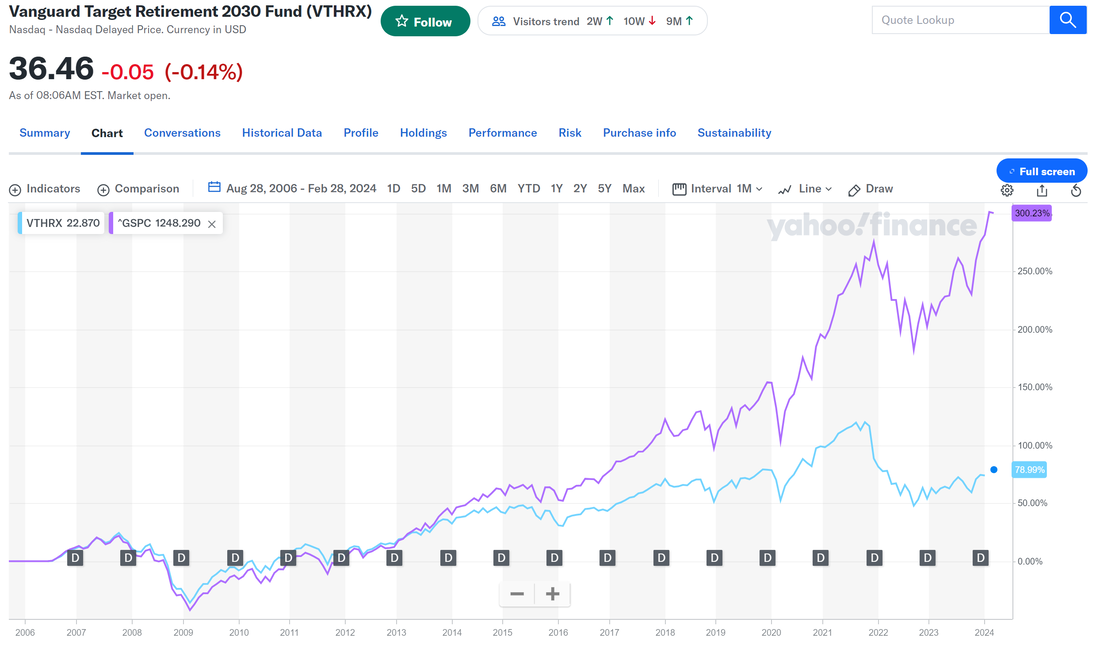|
I highlighted company-sponsored funds for utilizing target-date retirement funds and hindering the growth of your portfolio. While that strategy is not suitable for everyone because it lacks diversification, it raises the question: How can we create a diverse portfolio without sacrificing performance?
First, we need to identify the types of tools used for investing because they might be more diversified than you think. The most commonly used items are stocks, bonds, mutual funds, and Exchange-Traded Funds (ETFs). Stocks represent units of ownership in a company, offering upside potential and dividends. Bonds are units of debt in a company or government, paying interest over a set period and ensuring the value of your original investment. Mutual funds and ETFs are pooled investments that may include up to 500 various companies, aligned with an investing strategy or index. Traditionally, when building a portfolio before the emergence of mutual funds and ETFs, investors would choose uncorrelated companies to offset portfolio drawdowns. Conventional practice involved holding 20-30 positions. Nowadays, robo-advisors commonly employ model portfolios of 10-12 ETFs or mutual funds. However, the issue arises with over-diversification. For example, VOO, probably the most widely used ETF for robo-advisors, encompasses 500 companies. With a portfolio of 10-12 ETFs, you could end up holding positions in 6000 companies. To put this in perspective, the NYSE lists 8,000 securities available for trading. Diversification can mitigate portfolio drawdowns, but as the great Warren Buffet once said, "Diversification is protection against ignorance." If you lack the time to construct a portfolio and evaluate performance, seeking assistance from a professional is advisable. This can be achieved through a flat fee model or a percentage of accounts under management. There is no foolproof method to avoid drawdowns in a portfolio through diversification. Investing entails various risks: market, interest rate, or currency. Identifying your investing goals and devising a strategy to align with them is crucial to ensuring the suitability of your portfolio. Comparing your performance to others without considering their comfort level compared to yours is like comparing apples and penguins—it's illogical.
0 Comments
Stop setting Millennials and Gen Z up for investment failure; here's how to get more out of your 401k. Company-sponsored investment plans, commonly known as 401k, serve as the initial investment tool for most Millennials and Gen Z. If you haven't purchased a house yet, they could represent the primary source of your net worth. These sleeping giants are supposed to form the foundation for retirement, but many younger investors are being shortchanged. The issue lies in automatic investments in target-date retirement funds. What are target-date retirement funds? Target-date retirement funds consist of a pre-selected mix of stocks and bonds based on your planned retirement date. They typically include four groups: US Equities, International, US Bonds, and International Bonds. For instance, if you have 40 years until retirement, your target-date fund might allocate 90% to stocks and 10% to bonds. As you approach your retirement date, the allocation shifts, aiming for a balance of 60% stocks and 40% bonds. The idea is that, closer to retirement, a more conservative approach is adopted, with bonds serving as a less volatile investment option. However, for the past several years, bonds and developed international equities have consistently underperformed, resulting in diminished upside potential. Based on the information below, if you had started your job in 2006 and invested in a target-date retirement fund, you would have incurred a loss of 215%. In no way is this a diverse portfolio; we will look further into this in Part 2, 'When Does a Diverse Portfolio Matter?' If you are using this as your benchmark, you are not meeting your goal and may be pushing back your retirement date even further.
What should you do? Align your investment goals with a benchmark. Within your 401k, there are options for Large Cap Equity, Mid Cap Equity, Small Cap Equity, and International investments. Research these options, considering their costs, potential upside, and how well they align with your retirement goals and timeframe. Mark your calendar to regularly re-evaluate performance. While it's easy in theory, putting it into practice can be challenging; the better you are at creating and sticking to a schedule, the more you'll see your portfolio grow. Hot tips: While you might be locked into changing your previous allocations for 60-90 days, future contributions can always be adjusted. Set your calendar for 2-3 days before your pay period, so changes will take effect for upcoming paychecks. If you notice a market decline, leave it in a stable value fund and allocate it to the next payroll. None of this will come naturally, but over time you'll become familiar with the platform you're using. And, as always, feel free to come to me with questions. Helping those just entering the workforce invest like a pro is one of my favorite things. |
Archives
July 2024
Categories |
Financial Services are offered through Family Retirement LLC, a registered investment advisor. Family Retirement LLC is a registered investment advisor in the State of Washington. Family Retirement LLC may not transact business in states where we are not appropriately registered, excluded, or exempted from registration. Individual responses to persons that involve either the effecting of transactions in securities, or the rendering of personalized investment advice for compensation, will not be made without registration or exemption. Neither the firm nor its agents or representatives may give tax or legal advice. Individuals should consult with a qualified professional for guidance before making any purchasing decisions.
Privacy Policy | ADV Part2A
425-610-9226
1700 Westlake Avenue North Suite 200
Seattle, WA 98109
Copyright © 2024
Privacy Policy | ADV Part2A
425-610-9226
1700 Westlake Avenue North Suite 200
Seattle, WA 98109
Copyright © 2024


 RSS Feed
RSS Feed


